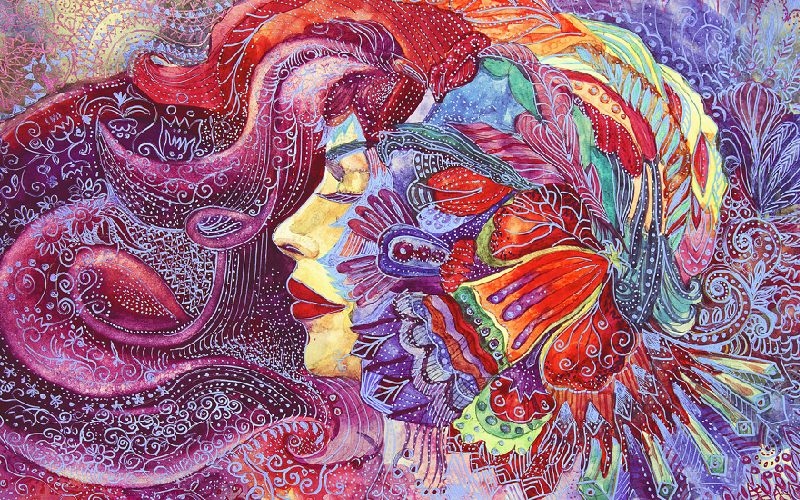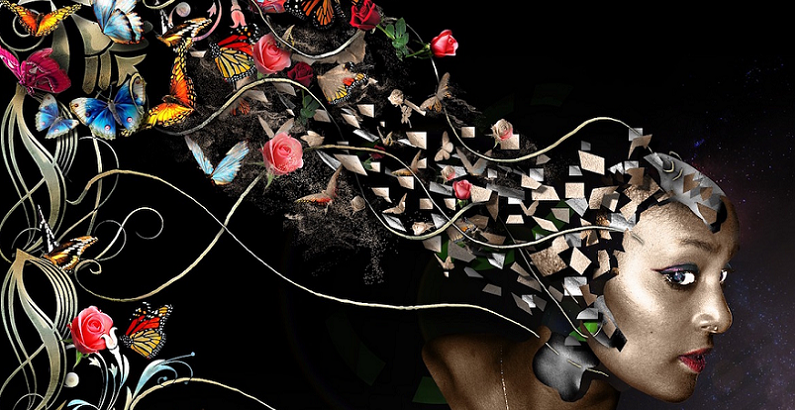
Visualization is a powerful tool that has been used for centuries across various spiritual traditions. By harnessing the mind’s ability to create vivid images and scenarios, individuals can connect more deeply with their inner selves and facilitate profound spiritual growth. This practice not only enhances mental clarity but also fosters a sense of peace and alignment with one’s higher purpose.
Contents
Introduction to Visualization
The practice of visualization not only enhances mental clarity but also fosters a sense of peace and alignment with one’s higher purpose.
Definition Of Visualization
Visualization is the practice of creating mental images and scenarios to influence the mind and body positively. It involves focusing on specific images, ideas, or goals to bring about a desired outcome. This practice has roots in ancient cultures and spiritual traditions, where it was used as a means of connecting with higher realms and achieving personal transformation.
Explanation Of Visualization In A Spiritual Context
In a spiritual context, visualization is a method to connect with one’s higher self and the divine. It allows individuals to see beyond the physical world and access a deeper level of consciousness. This form of mental imagery can lead to greater spiritual awareness and insight, helping practitioners to align their actions with their spiritual goals.
Historical Roots Of Visualization Practices
The use of visualization can be traced back to ancient civilizations such as the Egyptians, Greeks, and Hindus. These cultures believed in the power of the mind to influence reality and used visualization techniques in their spiritual rituals and healing practices. Over time, these methods have been adapted and integrated into various spiritual and religious practices around the world.
Importance Of Visualization For Spiritual Growth
Visualization plays a crucial role in spiritual growth by helping individuals focus their intentions and manifest their spiritual desires. It serves as a bridge between the conscious and subconscious mind, allowing for deeper self-discovery and transformation. By regularly practicing visualization, individuals can cultivate a more profound sense of inner peace, clarity, and connection to their spiritual path.
Connecting The Mind And Spirit
Through visualization, the mind and spirit become more aligned. This alignment enables individuals to experience a heightened state of awareness and a stronger connection to their inner self. Visualization acts as a conduit, bringing mental intentions into harmony with spiritual aspirations.
Enhancing Inner Peace And Clarity
One of the significant benefits of visualization is its ability to foster inner peace and mental clarity. By focusing on positive and calming images, individuals can reduce stress and anxiety, leading to a more balanced and serene state of mind. This inner peace is essential for spiritual growth, as it creates a stable foundation for exploring deeper aspects of the self [1].
The Science Behind Visualization
Understanding the science behind visualization can enhance its effectiveness and credibility as a spiritual practice. Both psychological and spiritual perspectives provide valuable insights into how visualization works and its impact on the mind and body.
Psychological Perspectives
From a psychological standpoint, visualization is seen as a powerful tool for harnessing the mind’s potential. It involves using the imagination to create vivid images that can influence thoughts, emotions, and behaviors.
The Role Of Imagination In Mental Processes
Imagination plays a crucial role in various mental processes, including learning, problem-solving, and emotional regulation. When individuals visualize, they engage the same neural pathways that are activated during actual experiences. This mental rehearsal can improve performance, reduce anxiety, and enhance overall well-being.
Studies On Visualization And The Brain
Numerous studies have shown that visualization can lead to measurable changes in the brain. Functional MRI scans reveal that visualizing an action activates the same brain regions as physically performing the action. This phenomenon suggests that visualization can effectively train the brain and body, leading to improved outcomes in various areas, including sports, education, and mental health.
Spiritual Perspectives
Spiritual perspectives on visualization emphasize its ability to connect individuals with higher states of consciousness and energy. This practice is often seen as a way to tap into the universal mind and access deeper levels of wisdom and insight.
Visualization In Different Spiritual Traditions
Many spiritual traditions incorporate visualization into their practices. For example, in Buddhism, practitioners use visualization to focus their minds and cultivate specific qualities, such as compassion and wisdom. In Hinduism, visualization is used in meditation and ritual to connect with deities and higher realms. These practices highlight the universal nature of visualization as a tool for spiritual growth [2].
The Energetic Impact Of Focused Imagery
Visualization is believed to influence the body’s energy systems, such as the chakras and meridians. By focusing on specific images and intentions, individuals can direct energy to different parts of the body, promoting healing and balance. This energetic impact underscores the holistic nature of visualization, as it integrates mind, body, and spirit into a unified practice.

Basic Techniques for Effective Visualization
Effective visualization requires specific techniques to maximize its benefits. By setting clear intentions and creating an optimal environment, individuals can enhance their practice and achieve better results.
Setting Intentions
Setting intentions is a crucial step in visualization. It involves defining clear goals and aligning them with personal values to create a focused and purposeful practice.
Defining Clear Spiritual Goals
To begin, it’s essential to identify what you want to achieve through visualization. These goals can be related to personal growth, healing, or spiritual enlightenment. Clearly defined goals provide direction and purpose, making the visualization process more effective.
Aligning Intentions With Personal Values
Once goals are established, aligning them with your core values ensures that your visualization practice is authentic and meaningful. This alignment helps maintain motivation and commitment, as the practice resonates with your deeper beliefs and desires.
Creating A Sacred Space
A conducive environment enhances the visualization experience. Creating a sacred space helps in achieving a state of relaxation and focus, essential for effective visualization.
Physical Environment Preparation
Choose a quiet, comfortable space where you won’t be disturbed. This space should be free from clutter and distractions, allowing you to focus entirely on your visualization practice. Adding elements like candles, incense, or soothing music can create a more serene atmosphere [3].
Mental And Emotional Readiness
Before starting your visualization, take a few moments to calm your mind and center your emotions. Techniques like deep breathing or a brief meditation can help prepare your mind and body, making the visualization practice more effective and enjoyable.
Advanced Visualization Practices
Once you have mastered the basic techniques, you can explore advanced practices to deepen your visualization experience. These methods can enhance the effectiveness of your visualizations and lead to more profound spiritual transformations.
Guided Visualization
Guided visualization involves following a narrative led by an external guide or a pre-recorded script. This method can be particularly helpful for those who find it challenging to create vivid images on their own.
Using Audio Guides And Scripts
Audio guides and scripts provide a structured approach to visualization, allowing you to focus solely on the imagery and sensations without worrying about the process. These guides often include soothing music and descriptive narratives that lead you through various scenarios, helping you achieve a deeper state of relaxation and focus.
Personalized Guided Sessions
Personalized guided sessions can be tailored to your specific goals and needs. Working with a spiritual coach or practitioner, you can create a custom visualization script that addresses your unique intentions. This personalized approach ensures that the visualization practice resonates deeply with your spiritual journey.
Visualization And Meditation
Combining visualization with meditation can amplify the benefits of both practices. This integration allows for a more profound connection between the mind and spirit, facilitating deeper insights and spiritual growth.
Combining Breathwork And Imagery
Incorporating breathwork into your visualization practice helps to anchor your mind and body in the present moment. Focused breathing techniques can enhance the clarity and vividness of your visualizations, making them more impactful and immersive.
Deepening The Meditative State With Visuals
Using visual imagery to deepen your meditative state involves focusing on specific images or symbols during meditation. This practice can help quiet the mind and direct your attention inward, leading to a more profound sense of peace and spiritual connection [4].
Symbolic Imagery
Symbolic imagery involves using specific symbols and archetypes in your visualizations to tap into universal energies and wisdom. This practice can add a deeper layer of meaning to your visualizations and enhance their transformative power.
Identifying Personal Symbols
Identifying symbols that hold personal significance can make your visualizations more meaningful and effective. These symbols can be derived from your spiritual beliefs, cultural background, or personal experiences. Incorporating them into your visualizations can create a powerful connection to your inner self and spiritual path.
Using Universal Archetypes
Universal archetypes are symbols that hold collective meaning across different cultures and spiritual traditions. Examples include the hero, the sage, and the healer. Using these archetypes in your visualizations can tap into the collective unconscious, providing access to deeper wisdom and insights.
Practical Applications of Visualization
Visualization can be applied in various aspects of life to bring about positive changes and spiritual transformation. By integrating visualization into daily practices, individuals can enhance their well-being, achieve their goals, and foster deeper spiritual connections.
Healing And Wellness
Visualization can be a powerful tool for promoting healing and overall wellness. By focusing on positive images and outcomes, individuals can influence their physical and emotional health.
Visualizing Health And Wholeness
Visualizing health involves creating mental images of your body in a state of complete health and wholeness. This practice can stimulate the body’s natural healing processes and strengthen the immune system. By regularly visualizing yourself as healthy and vibrant, you can foster a positive mindset that supports physical well-being.
Techniques For Emotional Healing
Emotional healing through visualization involves imagining scenarios where you release negative emotions and replace them with positive ones. Techniques such as envisioning a safe space or visualizing interactions where you express and resolve emotions can help process and heal emotional wounds. This practice can lead to greater emotional resilience and balance.
Manifesting Spiritual Goals
Visualization can be a powerful method for manifesting spiritual goals and desires. By clearly envisioning what you want to achieve, you can align your actions and energy with your spiritual aspirations.
Visualization For Abundance And Prosperity
To attract abundance and prosperity, visualize scenarios where you experience financial stability, success, and fulfillment. Imagine the specific details of your desired outcomes, such as the work you do, the lifestyle you lead, and the sense of gratitude and satisfaction you feel. This focused intention can help draw opportunities and resources into your life.
Techniques For Manifesting Love And Relationships
Visualizing loving and harmonious relationships involves creating vivid images of the qualities and experiences you desire in your connections with others. Whether seeking a romantic partner or improving existing relationships, focus on the emotions, interactions, and mutual support you wish to cultivate. This practice can attract and enhance meaningful, loving relationships in your life.
References
[1] Guided Visualization
[2] Visualization And How It Can Transform Your Life
[3] visualization
[4] Selfpause Affirmation

